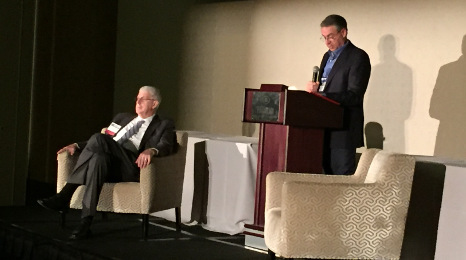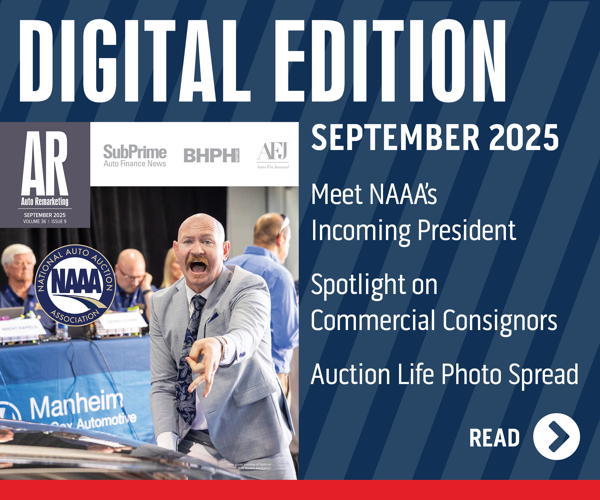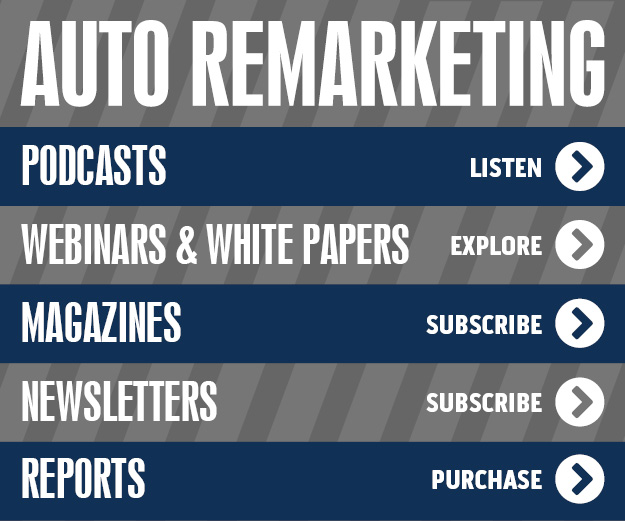New auto finance analysis from Edmunds shows increases in term length and monthly payments. These metrics have made headlines for some time now as potential buyers focus on what they can fit into their budgets.
But Edmunds also noticed an increase in another data point that might help to illustrate the work completed within the F&I office and finance company underwriting department — a significant rise in down payments for both used- and new-vehicle deliveries.
According to information released on Tuesday, the average down payment connected with used-vehicle financing came in at $2,468 in July, representing a 6.6-percent lift year-over-year and a 12.7-percent climb during the past five years.
On the new-model side, the average down payment in July stood at $3,621, marking a 7.3-percent increase year-over-year and a 10.0-percent rise since 2012.
The down-payment movement is likely especially positive for the industry on the new-car side since Edmunds reported the average transaction price for a new vehicle was $34,558 in July, which is 2 percent higher than July of last year.
Kelley Blue Book spotted a similar development as analysts there reported prices for new models rose by $573 year-over-year to land at $34,721 in July.
“Once again, the declining sales of cars and the growing popularity of SUVs is driving up the average transaction price,” Kelley Blue Book analyst Tim Fleming said.
Edmunds also noticed that interest rates on new-vehicle financing fell to a six-month low in July as automakers ramped up summer's zero-percent finance deals.
The annual percentage rate (APR) on new financed vehicles averaged 4.77 percent in July, down from 4.96 percent in June. And 11.3 percent of purchasers who financed took advantage of zero-percent financing, up from 9.47 percent in June and 10.2 percent a year ago.
“Zero-percent finance deals are common in the summer, but car buyers can save even more this year,” said Jessica Caldwell, Edmunds executive director of industry analysis. “Even though interest rates were lower on average in July than at any time in the past six months, they’re still hovering at highs not seen since 2009.
“These higher interest rates make zero-percent financing a big carrot for dealers seeking to lure car shoppers,” Caldwell continued as Edmunds’ data also indicated days to turn new metal in July was 76 days, the highest since July of 2009.
Overall, interest rates on new-model financing have been higher in 2017 than in recent years. July’s average APR is up 5.6 percent year over year and is 14.2 percent higher than it was five years ago.
“In today’s declining market, every sale counts,” Caldwell said. “We anticipate automakers will continue to ramp up zero-percent finance offers as we get deeper into the summer sell-down season.”
For used-vehicle financing, the average APR in July stood at 7.46 percent, which marked a 2.3 percent rise year-over-year. However, the latest reading also represents a 7.7 percent slide since 2012.
And when it comes to contract term length, Edmunds reported the average for used-vehicle contracts in July came in at 66.90 months. For new-model financing, the July average stood at 69.45 months.
GrooveCar added three new features to its vehicle-buying platform for credit unions; enhancements the company says are designed to continue to support the platform’s mission of boosting credit union engagement and lead generation.
The highly responsive design has made the additional new features easy to use for the multi-device user. These new features include:
—Market value pricing: A tool that can let members know what other consumers are paying for similar pre-owned vehicles in the area that they are researching.
—Finance calculator: A solution that now has the option for credit unions to include their life and disability insurance and GAP products within the monthly payment, allowing the member to find the loan payment they are most comfortable with while helping credit unions capture more revenue.
—Cloud storage: A platform for credit unions to access reports through their password-protected log-in area and use the extensive and most recent marketing materials designed specifically for them. This process can allow them to unlock the marketing potential of engaging members at any time without taking any resources (money and staff) away from the credit union.
“Our engineers have been busy, and we are excited to roll out several new features that will enhance the user experience while benefiting the credit union in terms of member engagement and loan activity,” said Robert O’Hara, vice president of strategic alliance at GrooveCar.
O’Hara continued that innovation in website design has provided new auto buying tools that deliver the best way for credit unions to reach members during the vehicle buying cycle. Websites require different features needed to deliver success; the GrooveCar platform continues to introduce next-generation technology to support the credit union's sales and marketing strategy.
“Designed with a wide-screen display supporting the multi-device user, we live in a world where sites are being visited by a variety of different devices, on-the-go, and at any given time, a website must be responsive to every changing need,” O’Hara said.
“We never want a member to visit the website and not find what they are looking for, on all devices. If this happens, there's a good chance you will lose them. Our features are compatible to optimize the experience across all platforms," O'Hara added.
“Meeting the needs of members, along with access to cloud-based messaging to deploy marketing strategies on the fly, is the ultimate in responsive digital marketing."
GrooveCar offered a way to learn more about how to use and promote the auto buying platform in a new training video that is available in the window at the top of this page or by following this link.
With interest gaining steam toward combating fraud, PointPredictive landed funding from Mosaik Partners, an expansion-stage venture capital fund, to enhance its efforts as a provider of fraud solutions to banks, lenders and finance companies.
PointPredictive announced on Wednesday that the company finalized the successful closing of Series A funding earlier this month. While no specific figures were disclosed, Mosaik Partners led the funding round as part of its initiative to invest in commerce-enabling technology companies.
“With fraud losses reaching historically high levels here in the U.S., we believe PointPredictive’s technology and consortium approach will become the standard in lending fraud detection,” said Miles Kilburn, a partner at Mosaik.
“What interested us in PointPredictive is that they have a proven management team, differentiated technology, a working solution that delivers a compelling ROI to their clients, and explosive growth potential with lenders lining up to participate. This fits right in with our investment profile,” Kilburn continued in a news release.
As part of the funding, Mosaik will take a minority interest in PointPredictive. Additionally, Kilburn will join the board of directors of PointPredictive to help the company continue to grow strategically.
PointPredictive will use the funding to respond to the growing demand for Auto Fraud Manager and Dealer Trace — solutions that can help finance companies uncover fraud patterns through a collaborative data consortium and machine learning. PointPredictive estimates between $4 to 6 billion in auto loan applications may have misrepresentations that lead to default and chargeoff. Auto Fraud Manager and Dealer Trace can help curb those losses by leveraging sophisticated algorithms that scan and score applications prior to loans being funded.
“Auto lenders want to collaborate to stop fraud,” PointPredictive chief executive officer and president Tim Grace said. “In the last six months, we’ve seen tremendous interest in our solution and we need to respond now to help lenders stop auto lending fraud.
"Mosaik Partners is the perfect investor — they understand our technology and have worked in our space for years,” Grace continued. “We’re using the funding to increase our team of fraud scientists, fraud experts and industry thought leaders that will help us revolutionize fraud detection in auto lending and beyond.”
The sentiment from dealers who participated in the latest survey from KeyBanc Capital Markets matched up with what CarMax executives recently shared about how potential subprime buyers are behaving.
Then, KeyBanc analysts projected what these same potential subprime customers could do during the second half of the year based on a pair of expectations.
First, KeyBanc described how softening subprime activity is impacting new-vehicle sales, which the firm thinks should produce another weaker new vehicle seasonally adjusted selling rate (SAAR) this month, settling in the mid-16 million range.
“Anecdotal commentary continued to suggest subprime traffic remained down despite intact credit availability, which we believe is weighing on new vehicle sales at the moment, but is likely to improve in the back half of the year, which leads us to believe the 17.2 million SAAR outlook is still appropriate,” KeyBanc said in its survey report that was shared with SubPrime Auto Finance News.
The analysts arrived at what CarMax conveyed during its latest conference call. CarMax reported that its subprime mix was down again in the quarter to approximately 10 percent of its sales volume. A year earlier, the level came in at 11.2 percent.
KeyBanc recapped that the drop by CarMax “appears driven by lower subprime consumer traffic as its subprime lenders’ behavior remained unchanged.”
Analysts returned to their May survey responses that touched on subprime credit availability. They explained the availability remained “consistently favorable” as 83 percent of respondents reported intact or improving subprime credit availability in May and only the remaining 17 percent reported a tightening in subprime availability.
So what does this mean as dealerships and the rest of the industry turn their focus on the second half of 2017 in less than a week?
“We believe subprime consumers will return to the market in the back half of the year as unemployment claims remain low and the mix of subprime lenders is shifting toward smaller, more competitive lenders, which should drive marketing efforts and subprime consumers back into the showrooms,” KeyBanc analysts said in the report.
Whether the customer is subprime or prime, the KeyBanc dealer survey showed 83 percent of respondents reported intact (33 percent) or increasing (50 percent) gross profit per unit in the F&I office.
“Favorable trend in F&I gross per unit (GPU) should continue to largely offset pressures in new and used vehicle GPU,” analysts said.
When it comes to used-vehicle gross, the dealer survey splintered evenly in three directions, with 33 percent of dealers seeing gross increase by $50 or more in May, another 33 percent watching gross tumble by $50 or more during that month and the remaining 34 percent noticing the metric stay flat year-over-year.
While acknowledging the ongoing pressure, dealers ended up almost evenly divided on the new-car side with about half watching gross soften by $50 or more and the remainder producing a gross rise of $50 or more.
Also of note, the KeyBanc survey mentioned parts and service gross profit continues to be a dealership highlight with 83 percent of respondents saying that margins in this department remain at near-record levels.
Leaders from defi SOLUTIONS and eOriginal are looking for the auto finance industry to take another significant evolutionary step. Just like when participants moved away from using fax machines to complete applications, Georgine Muntz and Theodore Papilliou want finance companies to go completely digital to reduce paper consumption and generate other benefits.
“There are lots of obstacles for many lenders who are considering going paperless that can seem insurmountable,” said Muntz, who is the chief operating officer at defi SOLUTIONS. “But I’ve seen firsthand how technology and process can overcome even the longest list of objections, and in the long-run create more time, accuracy and customer satisfaction.”
On Wednesday at 2 p.m. ET, Georgine Muntz is joining with Papilliou, who is eOriginal’s director of value engineering, for a discussion about the benefits of digital financing. During the free webinar, titled “Decoding Digital Lending for Vehicle Finance,” topics will include:
• How post-signature technology can provide critical visibility into the dealer/finance company transaction.
• How dealers and finance companies can strengthen partnerships with digital technology.
• How to leverage the secondary markets in a fully digital contract environment.
• How to make compliance your competitive advantage.
“With less paper we’ll all take a giant leap toward a better future,” said Muntz, who elaborated more about the potential of saving costs and improving experiences when going paperless in a blog post available here.
“Whether you’ve implemented certain digital lending processes or you’re new to the concept altogether, we invite you to join the webinar,” Muntz went on to say.
Registration for the webinar can be completed here.
FactorTrust recently finalized an innovative partnership with GOLDPoint Systems to integrate alternative credit data and scores into the online finance company’s originating, servicing and reporting processes, thereby enabling GOLDPoint’s lending clients to get a complete overview of creditworthy borrowers.
GOLDPoint Systems is a loan origination and servicing system that can enable lenders to fund loans with full-service decisioning support. The company is integrating FactorTrust’s alternative credit data services and scores into their platform for lenders.
“Traditional data sources do not accurately portray a comprehensive profile of all consumers, particularly those with credit scores less than 700,” FactorTrust chief executive officer Greg Rable said. “To gain more insights and intel on potential customers, it is imperative to pair highly predictive alternative credit data with traditional data.
“This partnership allows GOLDPoint Systems to do just that, enhancing their consumer lenders’ opportunities to better identify the right loan candidates,” Rable continued.
GOLDPoint Systems can provide solutions to help consumer lenders across verticals approve and fund loans faster and smarter.
“Our fully customizable products allow lending institutions of all types to grow and increase their revenue,” said Glen Twede, vice president, sales and marketing, GOLDPoint Systems. “Partnering with FactorTrust and integrating their alternative credit data means we can expand on that capability.”
FactorTrust has long-provided alternative credit data, analytics and risk scoring information that lenders need to make informed decisions about consumers. It is differentiated from the Big 3 bureaus by its more than 250 million unique, behavioral and transactional data points untapped by these traditional sources.
For more information on FactorTrust, visit www.FactorTrust.com or call (866) 910-8497.
Change seems to be always in the air in the auto finance space. Finance companies are adjusting underwriting to mitigate risk, maintain origination growth and watch for delinquency rises. Service providers are looking to improve their solutions while sustaining high levels of performance and compliance.
And the professionals who lead the way in these endeavors are the primary topic for the next print edition of SubPrime Auto Finance News, our annual look at Movers & Shakers.
To make sure we highlight some of the best of the best who keep finance companies and service providers successful, we’re seeking nominations from you — the industry leaders and individuals in the trenches who are helping consumers secure the transportation they need to maintain their quality of life.
“We want this collection of Movers & Shakers to represent why auto financing plays such a critical role not only in the automotive industry, but our entire economy,” said Bill Zadeits, publisher of SubPrime Auto Finance News. “We asking for your help to make sure we capture the professionals most deserving of recognition for the crucial part they play in keeping auto financing vibrant.”
Along with a high-resolution photograph of the professional, SubPrime Auto Finance News is asking nominators to answer these two questions about why this individual is among the top Movers & Shakers in auto financing. The questions are:
—How has this professional improved his/her skills and performance during their time with the company?
—How does this individual not only make the company better, but also his/her colleagues?
To submit your nomination, please send materials to SubPrime Auto Finance News senior editor Nick Zulovich at nzulovich@cherokeemediagroup.com. Nominations will be accepted through June 27.
And if you don’t already receive your free copy of SubPrime Auto Finance News, please go to www.autoremarketing.com/subprime/subscribe to submit your information.
This week, RouteOne highlighted that its eContracting platform reached a new milestone with 7.5 million booked eContracts. The threshold resulted in more than $200 billion in funded deals.
RouteOne indicated the growth can be attributed to the rising adoption by:
• More than 6,000 active eContracting Dealers
• 36 live and in-pilot eContracting finance sources
• 12 eContracting integrated dealer management systems
RouteOne said today’s digital retail environment is driven by evolving consumer expectations and demands the delivery of a better experience, convenience, and transparency. The company noted eContracting plays an integral part of this rapidly evolving landscape. It can provide consumers the convenience of faster funding, which saves dealers money on floor plan and courier fees. It increases efficiencies between dealers and finance sources by automating critical checkpoints and validating data upon entry.
This process can result in reduced bounced or held contracts. The digital workflow and benefits eContracting can provide to all parties is becoming a standard, and is more and more how business is done.
To support growth and further streamline dealer processes, RouteOne emphasized that it is continually enhancing the features offered to dealers who utilize eContracting, including:
• Remote document delivery, which can give consumers secure electronic access to their eContracted documents. At the same time, it can reduce printing costs and paper shuffling for dealers.
• Aftermarket rating and contracting, which can provide direct integration for dealers to their aftermarket providers, allowing them to retrieve product rates, register a product sale and execute a contract for an aftermarket product as part of the eContracting process and eSigning ceremony.
• Mobile signing application, which can allow dealers to present contracts to customers and capture their signatures on a tablet device, de-tethering the signing process to allow dealers to support consumers anywhere they wish to do business and reducing reliance on proprietary devices.
The company added finance sources are also benefiting from recent enhancements, including:
• Complete electronic validation and processing, which can provide finance sources a more robust funding package to enable automatic booking of eContracts with no human interaction. It can offers dealers faster funding by alleviating the need for manual review of contracts.
• eContracting certification for loan origination systems, which can help ensure that the technical implementation for finance source customers who choose eContracting, is a fast and easy process. It establishes standard functionality requirements that Loan Origination Systems must meet.
“RouteOne is very pleased to have accomplished these eContracting milestones in partnership with our owners and customers,” RouteOne chief executive officer Justin Oesterle said.
“We are committed to making the investments needed to support and lead the industry’s continued adoption of eContracting. It is becoming the standard for RouteOne users to the benefit of dealers, finance sources, and consumers,” Oesterle went on to say.
Dealers or finance sources interested in optimizing their F&I experience by implementing eContracting can contact RouteOne at (866) 768.8301 or www.routeone.com.
Experian Automotive tried again this week to pop the talk about a “subprime auto loan bubble.”
Analysts said, “There’s always someone who claims that the bubble is bursting. But a level-headed look at the data shows otherwise.”
According to Experian’s State of the Automotive Finance Market report, 30-day delinquencies dropped and subprime auto financing reached a 10-year record low for the first quarter. Analysts indicated the 30-day delinquency rate dropped from 2.1 percent in Q1 2016 to 1.96 percent in Q1 2017, while the total share of subprime and deep-subprime installment contracts dropped from 26.48 percent in Q1 2016 to 24.1 percent in Q1 2017.
“The truth is, lenders are making rational decisions based on shifts in the market. When delinquencies started to go up, the lending industry shifted to more creditworthy customers. This is borne out in the rise in customers’ average credit scores for both new and used vehicle loans,” analysts said.
Experian noted that the average customer credit score for a new-vehicle contract rose from 712 in Q1 2016 to 717 in Q1 2017.
The company added the average customer credit score for a used-vehicle loan rose from 645 in Q1 2016 to 652 in Q1 2017.
In what Experian called “a clear indication” that finance companies have shifted focus to more creditworthy customers, super prime was the only risk tier to grow for new-vehicle financing from Q1 2016 to Q1 2017. Super-prime share moved from 27.4 percent in Q1 2016 to 29.12 percent in Q1 2017.
All other risk tiers lost share in the new-vehicle financing category:
• Prime: 43.36 percent in Q1 2016 to 43.04 percent in Q1 2017.
• Nonprime: 17.83 percent in Q1 2016 to 16.96 percent in Q1 2017.
• Subprime: 10.64 percent in Q1 2016 to 10.1 percent in Q1 2017.
For used-vehicle financing, Experian spotted a similar upward shift in creditworthiness.
Prime and super-prime risk tiers combined for 47.4 percent market share in Q1 2017, up from 43.99 percent in Q1 2017.
At the low end of the credit spectrum, subprime and deep-subprime shares fell from 34.31 percent in Q1 2016 to 31.27 percent in Q1 2017.
“The upward shift in used vehicle loan creditworthiness is likely caused by an ample supply of late model used vehicles,” Experian analysts said. “Leasing has been on the rise for the past several years (and is at 31.06 percent of all new vehicle financing today).
“Many of these leased vehicles have come back to the market as low-mileage used vehicles, perfect for CPO programs,” they went on to say.
Experian also mentioned another key indicator of the lease-to-certified pre-owned impact is the rise in used-vehicle financing share for captives. In Q1 2017, captives had 8.3 percent used-vehicle share, compared with 7.2 percent in Q1 2016.
In other findings:
• Captives continued to dominate new-vehicle financing share, moving from 49.4 percent in Q1 2016 to 53.9 percent in Q1 2017.
• 60-day delinquencies showed a slight rise, going from 0.61 percent in Q1 2016 to 0.67 percent in Q1 2017.
• The average new vehicle contract reached a record high of $30,534.
• The average monthly payment for a new vehicle installment contract reached a record high of $509.
Mark Floyd is the current and Steve Hall is the immediate past president of the National Automotive Finance Association.
In their own ways, both Floyd and Hall conveyed to the attendees of the NAF Association’s 21st annual Non-Prime Auto Financing Conference how the organization resembles a community with members who are more like friends than just industry participants or even competitors.
“I always considered Steve one of the thought leaders in our organization,” Floyd said during the opening segment of Thursday’s conference activities. “I didn’t always agree with him, but he’s someone who I would consider that makes us think outside the box.”
While Hall couldn’t attend this week’s gathering, he shared a note with NAF Association leadership that Floyd shared in part. Hall used some terminology that triggered this reaction Floyd acknowledged: “When I first read that I thought, ‘Really, Steve?’ … Then I thought, he’s got something here.”
What Floyd initially questioned was Hall trying to convey that the NAF Association should generate a “tribal culture.” Hall’s reasoning stemmed from what members are facing nowadays — particularly finance companies that operate in the non-prime and deeper portions of the credit spectrum. The trials include rising delinquencies, a potential reduction in capital availability as well as the ongoing pressure to perform by stakeholders and regulators.
Floyd turned back to Hall’s note, telling several hundred attendees, “As we think about some of the challenges we’re facing today, we’ve seen most of them before. So we should be thinking about what tools, analytics, educational programs and content we can give our members to help them be successful, which (NAF Association executive director Jack Tracey) and the team have done a really great job of.”
Floyd continued with Hall’s sentiment, saying, “I think there is an opportunity to create a tribal culture within our membership where people feel a part of group that has common values, beliefs, customs and rituals — interesting choice of words — about how the subprime industry should function. We can create a community where people come together to help each other be successful. That’s really what we do here.”
While the NAF Association has hosted this event filled with training and updates on regulatory matters, industry trends and networking for more than two decades, Floyd recalled the first time he attended this conference.
“I think it was 1996,” Floyd said as he gestured from behind a lectern adding, “We could fit everybody in half of one of these sections; it was about 25 or 30 people.
“I remember thinking I’m not really sure I want to be part of this group,” Floyd continued. “And I’m glad I’ve been part of the group. We’ve grown friendships and we’ve grown a community. It’s really a nice group to be a part of.
“I feel like the conversations I have with everybody, we really are looking out for each other. That’s that tribal community Steve was talking about. I feel that and that’s a genuine feeling. I feel that from people I talk with in the industry,” Floyd went on to say.
Thursday’s activities included a back-and-forth conversation involving Calvin Hagins, deputy assistant director for originations at the Consumer Financial Protection Bureau, and Michael Benoit, who is chairman at Hudson Cook. Panel sessions about capital availability and a major accounting change associated with reserving for potential losses as well as the final conference presentation by retiring Cox Automotive chief economist Tom Webb filled the day.
Floyd agreed with the closing portion of Hall noted when he shared that the NAF Association is “where people feel they are a part of a group of like-minded and valued leaders who are committed to helping each other pursue greatness in their businesses.”
Editor’s note: More expert analysis from the 21st annual Non-Prime Auto Financing Conference will be included in future reports distributed through SubPrime News Update.












